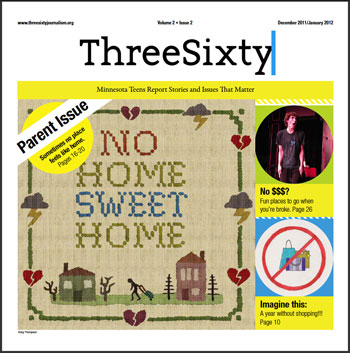Relationships between parents and teens often tread a thin and delicate line. Arguments about curfews, Facebook, grades, music and money can easily disrupt the harmony. Parents’ problems with divorce, unemployment, foreclosure and illness can add more wood to the fire.
Disagreements are common, even expected, but they can sometimes go awry and leave teens paying the price.
In ThreeSixty Journalism’s Dec 2011/Jan 2012 magazine issue, teen reporters from high schools throughout the Twin Cities write about what can go wrong in relationships with parents, ways to make things better, and other issues that matter to them.
ThreeSixty Journalism is a program of the University of St. Thomas’ College of Arts and Sciences and works year-round to train and mentor high school students in journalism skills. The teens work with ThreeSixty Journalism staff, Twin Cities’ professional journalists, and St. Thomas professors and learn by producing content for the ThreeSixty Journalism print magazine and website – from coming up with ideas to doing research, interviewing, writing, shooting photos and editing.
Their work has culminated into articles and essays about how teens work to succeed even when parents fail them, how to keep their foreign culture while adapting to life in America, how to have fun on a low budget and much more.
Here’s a closer look at what you’ll find in this issue:
- When family breaks. After her family splits apart, one teen builds a new sense of home.
- Teens least likely to be adopted. Teens tend to get caught in the foster care system because often parents looking to adopt have concerns about older children.
- Choosing sides. Having more Somali girls at school helped one teen connect more with her culture. But she didn’t want to leave old friends behind.
- Sculpture gardens for scamps. A free sculpture garden where touching the art is encouraged.
These teens are learning the skills of journalism while providing the community with a glimpse into the teen experience. More than 11,000 copies of the magazine are going to 200 middle schools, high schools, public libraries and youth organizations. Teachers use them to teach nonfiction, promote writing and discuss articles and story ideas.







